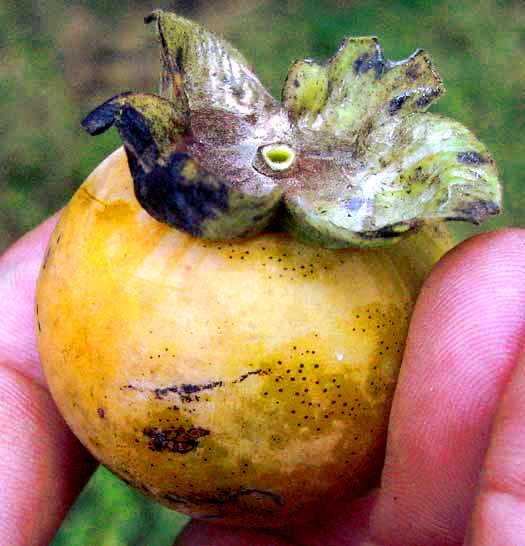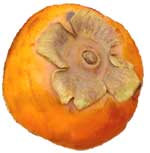Excerpts from Jim Conrad's
Naturalist Newsletter

from the the August 26, 2012 Newsletter written at the woods edge in the Loess Hill Region a few miles east of Natchez, Mississippi, USA
PERSIMMONS TURNING YELLOW
When I was a kid back in Kentucky we used to tell one another to not bite into a persimmon until frost had sweetened them. Later in Mississippi I learned that in the fall persimmon fruits can be perfectly sweet without having experienced frost. Still, I've been thinking of persimmon fruits as late fall fare, so I was surprised this week to find fruits here already turning yellow, as you can see above.
After a mild winter, spring this year arrived three or four weeks early so maybe that explains the early yellowing. Of course the fruits still are way too hard and puckery to eat.
When a tree's branches are heavy with persimmon fruits it's easy to identify it as a Persimmon tree, which is DIOSPYROS VIRGINIANA. However, the Persimmon tree's simple leaves with no lobes or serrations on their margins are fairly similar to other trees such as Blackgum, Sourwood, Shingle Oak and more -- so fruitless trees can be hard to distinguish for beginners. One field mark distinguishing a Persimmon's leaf from a leaf of those other species is the longish, reddish, velvety petiole, and the leaf's rounded base.
You can't mistake a persimmon fruit for anything else, though, as you can see below:

The spectacular feature of a persimmon fruit is its leathery, starfish-like "cap," which is what the flower's calyx has become. In most flowers the calyx is a green, inconspicuous part below a colorful corolla. However, once a Persimmon tree's flowers are pollinated the corolla shrivels away as it's supposed to, but the calyx -- at least on female flowers -- begins growing and toughening until it becomes what's shown in the picture.
Why do Persimmon trees expend such energy affixing large, tough calyxes to their fruits, when similar fruits such as apples and peaches do perfectly well without such appendages? In "Plant Physiology" magazine {August 2012, 159 (4)} Nakano et al say that Persimmon calyxes bear many stomata and serve as "gas exchange organs" responsible for sensing and regulating not only water stress, but other environmental factors as well. Moreover, developing calyxes contain chlorophyll and photosynthesize just as efficiently as leaves.
Between 400 and 500 persimmon species -- species in the genus Diospyros -- are recognized, with four species listed for North America. Most persimmon species are found throughout the world's tropics. Our North American species can be thought of as unusual Temperate-Zone manifestations of a mainly tropical genus. Persimmons are members of the Ebony Family, the Ebenaceae, which itself is predominantly tropical and subtropical. The most famous members of the genus Diospyros are the Ebony tree with its beautiful, black, dense wood, and the Japanese Persimmon, whose enormous fruits now are sold in many supermarkets. Mexico's Black Zapote, or Zapote Negro, is a persimmon, Diospyros digyna.
from the BackyardNature.Net Website's "Persimmon Flower Page":
PERSIMMON FLOWERS
Persimmon trees, Diospyros virginiana, are common trees throughout the eastern US south of a line from about southern New York to eastern Kansas.
Typically Persimmon trees are either male or female, and of course only the females bear fruit -- which are quite tasty if fully ripe but mind-boggelingly puckery otherwise!

In the above photo you see a cluster of male flowers at the top, and a single female flower at the bottom, right. Note that the male flowers are smaller and appear in small clusters, while the larger female flower appears alone. The female flower is 7/16 inch high (1 cm)
 Besides the fact that Persimmons have separate male and female flowers, they differ from our Standard Blossom by having an urn-shaped corolla with small lobes that curl backwards. Also, notice that the male flowers have typical calyces, but the female's calyx is very large and thick. As the pistil grows and matures into a Persimmon fruit, the calyx enlarges tremendously and becomes semi-woody, as shown at the left. In typical flowers, the calyx shrivels up or remains small and inconspicuous.
Besides the fact that Persimmons have separate male and female flowers, they differ from our Standard Blossom by having an urn-shaped corolla with small lobes that curl backwards. Also, notice that the male flowers have typical calyces, but the female's calyx is very large and thick. As the pistil grows and matures into a Persimmon fruit, the calyx enlarges tremendously and becomes semi-woody, as shown at the left. In typical flowers, the calyx shrivels up or remains small and inconspicuous.

Above you see cross-sections of the above flowers. Notice how the pollen-producing stamens inside the male flower nearly fill the corolla. Inside the female flower, the pistil with its four styles looks about like you'd expect, but also notice that there appear to be stamens leaning over the ovary. They are indeed stamens, though they are noticeably smaller than those in the male flower. The stamens in a Persimmon's female flowers are usually sterile. The interesting word here is "usually," for rarely the stamens in such female flowers do produce pollen, so rarely a tree with female flowers can produce fruit without another tree with male flowers being around!
from the May 16, 2004 Newsletter, issued from near Natchez, Mississippi:
PERSIMMON TREES FLOWERING
This week Persimmon trees next to my trailer were flowering. Lately I've come upon several large male trees beneath which the ground was practically yellow with discarded blossoms, for once the flowers' anthers release their pollen, the blossoms fall off, and the male tree can then take the rest of the summer off, focusing strictly on photosynthesizing and growing.
For flowers on female trees, however, the season's work has just begun. Throughout the entire summer their tiny pistils will gradually enlarge, the ovules inside them slowly maturing into those hard, thumbnail-size seeds that next fall will show up in raccoon poop along the trail.